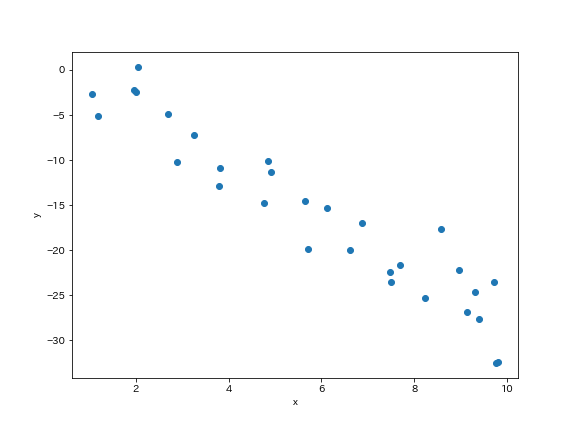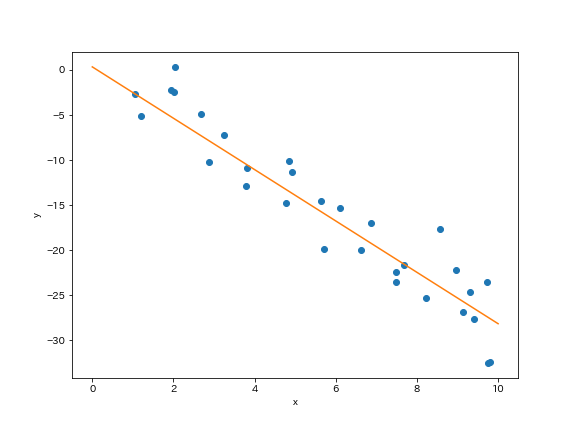信州大学 kstm Advent Calendar 2018の4日目です
最近BigQueryやSQLServerに機械学習系のアルゴリズムが追加されてますね.
今回はSQLの再帰クエリを使って最急降下して遊びました.
最急降下法
関数$f(x)$について,以下の更新式で極値となるパラメータの値を求めます.
$$
x \leftarrow x - \eta \frac{\partial\mathcal{f}}{\partial x}
$$
ためしにSQLで次の関数を最小化してみましょう.
$$
y(x) = x^2 - 6x + 9
$$
$y' = 2x - 6$,学習率を$\eta=0.01$とするとこんなかんじ
with
recursive gd(iter, x, y) as (
select
0, cast(0.0 as decimal(6,3)), cast(9 as decimal(6,3))
union all
select
iter+1, x-0.01*(2.0*x-6.0), pow(x-0.01*(2.0*x-6.0),2)-6*(x-0.01*(2.0*x-6.0)) + 9
from
gd
where
iter < 1000
and y - (pow(x-0.1*(2.0*x-6.0),2)-6*(x-0.1*(2.0*x-6.0)) + 9) > 0.001
)
select * from gd order by iter desc limit 1
結果は...
| iter | x | y |
|---|---|---|
| 197 | 2.941 | 0.003 |
できた!
線形回帰もやってみる
$y \sim \mathcal{N}(a + bx, \sigma)$のようなデータを適当に作っておきます.
ここでは$a=1, b=-3$にしました.
誤差関数と更新式は以下.
$$ \mathcal{L} = \frac{1}{2N} \sum_{i=1}^{N}(a+bx_i-y_i)^2 $$
\begin{align}
\frac{\partial\mathcal{L}}{\partial a} &= \frac{1}{N} \sum_{i=1}^{N}(a+bx_i-y_i) \\
\frac{\partial\mathcal{L}}{\partial b} &= \frac{1}{N} \sum_{i=1}^{N}(a+bx_i-y_i)x_i
\end{align}
学習率$\eta=0.01$で,誤差の変化が$0.01$以下になったら終了するようにしました.
with
recursive agg as (
select
sum(x) s_x,
sum(y) s_y,
sum(x*x) s_x2,
sum(y*y) s_y2,
sum(x*y) s_xy,
count(*) n
from lr
),
gd(iter, a, b, loss) as (
select
0, cast(1.0 as decimal(10, 5)), cast(1.0 as decimal(10, 5)), cast(100.0 as decimal(10, 5))
from lr
union all
select
iter+1,
a-0.01*(n*a+b*s_x-s_y)/n,
b-0.01*(a*s_x+b*s_x2-s_xy)/n,
(n*pow(a-0.01*(n*a+b*s_x-s_y)/n,2)
+pow(b-0.01*(a*s_x+b*s_x2-s_xy),2)*s_x2
+s_y2
+2*(a-0.01*(n*a+b*s_x-s_y)/n)*(b-0.01*(a*s_x+b*s_x2-s_xy))*s_x
-2*(a-0.01*(n*a+b*s_x-s_y)/n)*s_y
-2*(b-0.01*(a*s_x+b*s_x2-s_xy))*s_xy)/(2*n)
from
gd, agg
where
iter < 5000
and loss > 0.1
and abs(
loss-(n*pow(a-0.01*(n*a+b*s_x-s_y)/n,2)
+pow(b-0.01*(a*s_x+b*s_x2-s_xy),2)*s_x2
+s_y2
+2*(a-0.01*(n*a+b*s_x-s_y)/n)*(b-0.01*(a*s_x+b*s_x2-s_xy))*s_x
-2*(a-0.01*(n*a+b*s_x-s_y)/n)*s_y
-2*(b-0.01*(a*s_x+b*s_x2-s_xy))*s_xy)/(2*n)) > 0.01
)
select * from gd order by iter desc limit 1
結果はこちら
| iter | a | b | loss |
|---|---|---|---|
| 18 | 0.34115 | -2.84881 | 3.31067 |
いいかんじですね.
今回の実装を実行したnotebookはこちらです.

